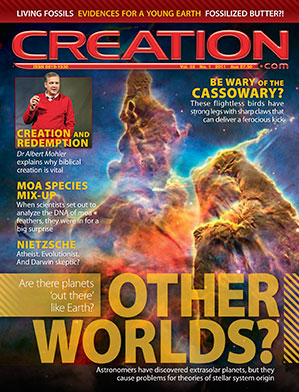Living Fossils: the Shovelnose Ray

Right: A living ray (Rhinobatos productus) caught at Malibu, California, USA.
The sheer number of ‘living fossils’ provides amazing testimony to recent creation.
It is striking to see a well-preserved fossil specimen next to a living organism that is virtually identical, but with supposedly many millions of evolutionary years separating them. A picture (or two, in such cases) really is worth a thousand words.
Compare the living Shovelnose Ray on the right, with the fossil specimen, from the Carnegie Museum of Natural History in Pittsburgh, USA. The fossil comes from the famous (‘lithographic’) limestone in Solnhofen, Germany.1 The official ‘date’ is Jurassic (‘dinosaur-age’), 148 million years.
There is obviously ‘no evolution’ here. But the astonishing similarities also raise serious doubts about the huge timespan allegedly separating the two specimens. In a creationist scenario, based on real-world observations, mutations are occurring continually, and natural selection is a simple fact (though causing downhill, not uphill change2). To have creatures ‘staying the same’ to such a degree for even a few tens of thousands of years is highly unlikely. Consider the constantly changing pressures of the environment, including the dynamic and changing interplay between the organism, the food available to it, and its predators.3
Note that the evolutionists tacitly show that they are aware of this problem by giving the fossil creature a different scientific name from its living counterpart—even a different genus! To admit that two creatures supposedly 148 million years apart were the same species would, it seems, be too difficult.
Dr Carl Werner, who provided these photos, has put together a stunningly beautiful book on ‘living fossils’. The 274 full-colour pages feature an astonishing number of different living fossils, many of them original discoveries, with fascinating discussions. It’s a great conversation-starter for your living room, with powerful photographic evidence of things most people are completely unaware of.
References and notes
- The famous Archaeopteryx fossil was discovered there. The limestone is very finegrained, which made it useful for printing, hence ‘lithographic’. Return to text.
- See Muddy Waters. Return to text.
- It would of course remain the same kind, even while its genome was degenerating (see genetic engineering pioneer Dr John Sanford’s classic Genetic Entropy and the Mystery of the Genome). The relentless forces of genetic entropy would ensure extinction in much less time than a million years, if such time were ever available. Return to text.




Readers’ comments
Comments are automatically closed 14 days after publication.